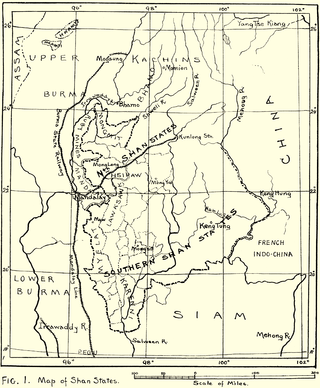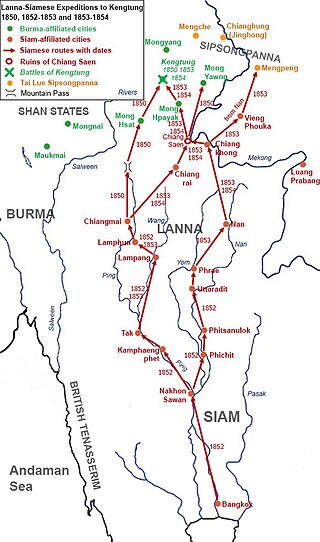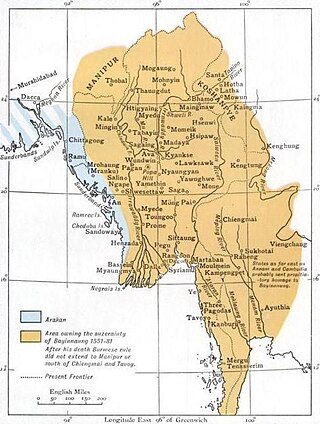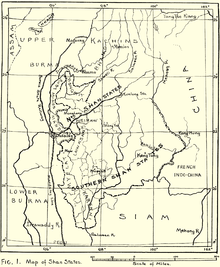
The Shan people, also known as the Tai Long or Tai Yai, are a Tai ethnic group of Southeast Asia. The Shan are the biggest minority of Burma (Myanmar) and primarily live in the Shan State of this country, but also inhabit parts of Mandalay Region, Kachin State, Kayah State, Sagaing Region and Kayin State, and in adjacent regions of China, Laos, Assam and Meghalaya, Cambodia, Vietnam and Thailand. Though no reliable census has been taken in Burma since 1935, the Shan are estimated to number 4–6 million, with CIA Factbook giving an estimate of five million spread throughout Myanmar which is about 10% of the overall Burmese population.

Shan State, also known by the endonym Shanland, is a state of Myanmar. Shan State borders China (Yunnan) to the north, Laos to the east, and Thailand to the south, and five administrative divisions of Burma (Myanmar) in the west. The largest of the 14 administrative divisions by land area, Shan State covers 155,800 km2, almost a quarter of the total area of Myanmar. The state gets its name from Burmese name for the Tai peoples: "Shan people". The Tai (Shan) constitute the majority among several ethnic groups that inhabit the area. Shanland is largely rural, with only three cities of significant size: Lashio, Kengtung, and the capital, Taunggyi. Taunggyi is 150.7 km northeast of the nation's capital Naypyitaw.
Anaukbaklun was the sixth king of Taungoo Burma and was largely responsible for restoring the kingdom after it collapsed at the end of 16th century. In his 22-year reign from 1606–1628, Anaukpetlun completed the reunification efforts begun by his father, King Nyaungyan. Having inherited a partial kingdom comprising mainly Upper Burma and the Shan States from his father, Anaukpetlun went on to reconquer Lan Na in the east, and in the south, Lower Burma from rival Burmese factions and the Portuguese, as well as the Upper Tenasserim from the Ayutthaya Kingdom. The kingdom was known as the Restored Taungoo Kingdom or Nyaungyan Dynasty.

Wuntho or Waing Hso was a native state of Upper Burma when Burma (Myanmar), was under British control. It had an area of around 6,200 square kilometres (2,400 sq mi) with 150,000 inhabitants and lay midway between the Ayeyarwady River and Chindwin Rivers.

Mang Lon, Manglon, Manglun, Manglön, or Mang Lön a state in the northern Shan states of Myanmar, was formerly the chief state of the Wa people. It is a mountainous territory, including the valleys of the Salween and its tributary the Nam Hka. It had an approximate area of 7770 km² and its estimated population in 1911 was 40,000.

Yawnghwe, known as Nyaungshwe in Burmese, was a Shan state in what is today Myanmar. It was one of the most important of the Southern Shan States. Yawnghwe state included the Inle Lake. The administrative capital was Taunggyi, located in the northern part of the state. The Agent of the British government, the Superintendent of the Southern Shan States, resided at Taunggyi and the king's palace was at Yawnghwe.

Kingdom of Rattanatingsa or Kingdom of Chiang Mai was the vassal state of the Siamese Rattanakosin Kingdom in the 18th and 19th century before being annexed according to the centralization policies of Chulalongkorn in 1899. The kingdom was a successor of the medieval Lanna kingdom, which had been under Burmese rule for two centuries until it was captured by Siamese forces under Taksin of Thonburi in 1774. It was ruled by the Thipchak Dynasty and came under Thonburi tributary.

Hsipaw, also known as Thibaw, is the principal town of Hsipaw Township in Shan State, Myanmar on the banks of the Duthawadi River. It is 200 kilometres (120 mi) north-east of Mandalay.

Kantarawadi, also known as Gantarawadi, was one of the Karenni States in what is today Kayah State in Burma. It was also known as "Eastern Karenni" owing to the location of part of its territory east of the Salween River.

The Burmese–Siamese War of 1849–1855 or Siamese Invasions of Kengtung or Kengtung Wars were military expeditions of the Siamese Rattanakosin Kingdom against the Tai Khün State of Kengtung, which had been under Burmese suzerainty under the Konbaung dynasty. The dynastic struggles in Tai Lue State of Chiang Hung or Sipsongpanna prompted Siam, in cooperation with the Kingdom of Lanna, to invade Kengtung in order to gain access to Chiang Hung. In the First Invasion in 1850, the Siamese court had ordered the Lanna Lord of Chiang Mai to organize the offensives against Kengtung. Lanna troops failed to conquer Kengtung. Two other expeditions occurred in 1852 and 1853 as Bangkok commanded its troops to directly participate in the invasions. Both expeditions also failed because of internal issues and geographical unfamiliarity. The State of Kengtung under the leadership of Saopha Maha Hkanan, with limited assistance from Burma who had been embroiling in the Second Anglo-Burmese War, managed to resist Siamese-Lanna invasions three times.

Hsipaw, also known as Thibaw, was a Shan state in what is today Myanmar. Its capital was Hsipaw town. Hsipaw State was perhaps one of the most well known and powerful Shan States.

Mongmit or Möngmit, also known as Momeik, was a Shan state in the Northern Shan States in what is today Burma. The capital was Mongmit town. The state included the townships of Mongmit and Kodaung.

Mawkmai, also known as Maukme, was a Shan State in what is today Burma. It belonged to the Eastern Division of the Southern Shan States.

Mongnai, also known as Möngnai, Mone, Mōng Nai or Monē, was a Shan state in what is today Burma. It belonged to the Eastern Division of the Southern Shan States. Its capital was Mongnai town.

Lawksawk, also known as Yatsawk was a Shan state in what is today Burma. It was located north of Myelat and belonged to the Central Division of the Southern Shan States. Its capital was Lawksawk town. The state included 397 villages and the population was mostly Shan, but there were also Danu, Pa-O and Palaung people in the area.

Kengtung, known as Menggen Prefecture or Möng Khün Chiefdom or Mueng Khuen Fu from 1405 to 1895, was a Shan state in what is today Burma. The capital and the residence of the ruler was Kengtung in the centre of the state. It was the only urban area in this mountainous state whose landscape is dominated by the Daen Lao Range.

Mongyawng or Möngyawng was one of the Shan states. It was located in the narrow wedge of territory that projects eastwards from Kengtung State between China and Laos.

Mogaung or Möngkawng was a Shan state in what is present-day Myanmar. It was an outlying territory, located away from the main Shan State area in present-day Kachin State. The state existed until 1796. The main town was Mogaung.

Burmese-Siamese War (1802–1805) was the military conflict between the Kingdom of Burma under the Konbaung dynasty and Kingdom of Siam under the Chakri dynasty over the Lan Na city-states. It is composed of two parts: the Burmese Invasion of Chiang Mai in 1802 and the Siamese Invasion of Chiang Saen in 1804. The Burmese King Bodawpaya attempted to reclaim the lost dominions in Lan Na, east of Salween River. Lan Na, under leadership of Prince Kawila of Chiang Mai with Siamese support, successfully repelled the Burmese invasion. The Siamese under King Rama I then dispatched troops, in retaliation, to attack Burmese Chiang Saen in 1805. The town of Chiang Saen surrendered and came under Siamese rule. The wars resulted in the permanent eradication of Burmese influence from Lan Na.











